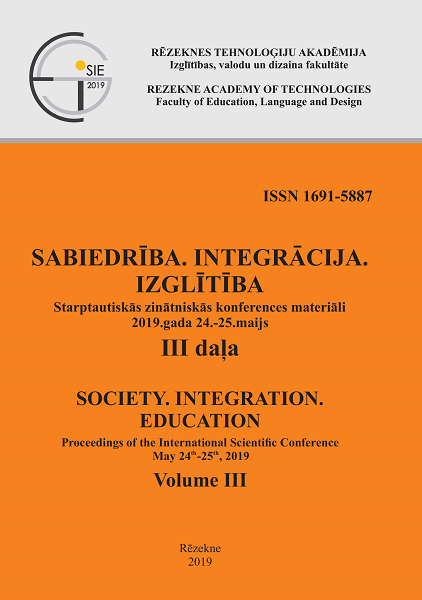STALKING AND CYBERSTALKING AS A FORM OF VIOLENCE
DOI:
https://doi.org/10.17770/sie2019vol3.4008Keywords:
violence, stalking, cyberstalkingAbstract
Experiencing violence is one of the greatest threats to human freedom and security. Consequences of violence, both physical - such as bruises, cuts, fractures, and even death, as well as mental - aggression, mental health problems, low self-esteem, emotional and cognitive disorders, can be drastic and permanent for the victim. Widespread and easy access to the media increases the risk of experiencing violence and its consequences. It is therefore important to make the public aware of possible types of violence and to conduct research in this area to help specialists in the field of psychology, law, pedagogy and psychotherapy as well as law enforcement agencies and network service providers to create effective prevention strategies.
References
Barlińska, J. (2013). Cyberbullying in adolescents - on the role of the medium, own experience and empathy in behaviour of witnesses to peer electronic violence, PhD thesis written under the supervision of dr hab. Anna Szuster-Kowalewicz prof. UW, Warsaw: UW. Retrieved from http://depotuw.ceon.pl/bitstream/handle/item/265/doktorat.pdf?sequence=1.
Bocij, P. (2006). The Dark Side of the Internet. London: Praeger Publishers.
Cupach, W. R., & Spitzberg, B. H. (2004). The Dark Side of Relationship Pursuit. Mahway: Lawrence Erlbaum Associates, Inc..
Douglas, K. S., & Dutton, D. G. (2001). Assessing the link between stalking and domestic violence, Aggression and Violent Behaviour, 6, pp. 519-546.
Farnham, F. R., James, D. J., & Cantrell, P. (2000). Association between violence, psychosis, and relationship to victim in stalkers, The Lancet, 355, (15), p. 199.
Forensic Perspectives, Meloy J. R. (Eds.). (1998), London: Academic Press, pp. 1–23.
Forward, S., & Buck, C. (1997). Toxic passions. Warsaw: Pub. Jacek Santorski & CO.
Groth, J. (2010). Cyberstalking - psychological perspective, Educational Forum 2(43), pp. 85-98.
Hare, R. D. (1996). Psychopathy: a clinical construct whose time has come, Criminal Justice Behaviour, 23, pp. 25-54.
Lindberg, D. (2012). Prevention of Cyberstalking: A Review of the Literature. Criminology and Criminal Justice Senior Capstone Project, Portland State University.
Meloy, J. R. (2010). The Psychology of Stalking. In Meloy (Ed.) The Psychology of Stalking: Clinical and Forensic Perspectives, London: Academic Press, pp. 2-21.
Meloy, J. R., & Gothard, S. (1995). A demographic and clinical comparison of obsessional followers and offenders with mental disorders, American Journal of Psychiatry, 152, pp. 258–263.
Mullen, P., Pathé, M., Purcell, R., & Stuart, G. (1999). A Study of Stalkers, The American Journal of Psychiatry, no. 156/1999, pp. 1244-9.
Nowicka, I. (2017). The phenomenon of stalking in the context of penitentiary resocialization, a few remarks, Humanistic Scientific Notebooks - Human Rights, no. 1 (20)/2017. Retrieved from http://www.humanrights.com.pl/pdf/Tom20/10.%20Izabela%20NOWICKA%20-%20Zjawisko%20stalkingu%20w%20kontek%C5%9Bcie%20resocjalizacji%20penitencjarnej.%20Kilka%20uwag.pdf, p. 165-175.
Pielichowski, J. (2013). Compendium of law and psychology in the field of stalking, Legal knowledge, 6/20, http://www.wiedzaprawnicza.pl/teksty/6-2013/6-2013.pdf, pp. 29-48.
Pyżalski, J. (2012). Electronic aggression and cyberbullying as new risky behaviour of young people. Kraków: Impuls Publishing House.
Skarżyńska-Sernaglia, J. (2009). Stalking in Poland – occurrence and characterization of the phenomenon. Retrieved from http://psychologia.net.pl/artykul.php?level=415.
Skarżyńska-Sernaglia, J. (2009a). Stalking: from love to crime - a new challenge for psychology, criminology and interdisciplinary teams that counteract violence, Львівського державного університету внутрішніх справ НАУКОВИЙ ВІСНИК 1/2009 (Lviv State University of Internal Affairs, Collection of scientific works). Retrieved from http://www2.lvduvs.edu.ua/documents_pdf/visnyky/nvsp/01_2009/09ssjipp.pdf, pp. 1-15.
Sobolewski, S. (2017). Stalking: persistent harassment - description of the crime. [Web log post]. The checkout. Retrieved from http://adwokat-sobolewski.pl/stalking-uporczywe-nekanie/.
Szopa, B. (2015). Stalking in Poland – some statistics. [Web log post]. Retrieved from https://stalking.com.pl/2015/09/29/stalking-w-polsce-statystyka/.
Szopa, B. (2016). Harassment on the Internet. [Web log post]. Retrieved from https://stalking.com.pl/2016/01/11/nekanie-w-internecie/.
Szopa, B. (2018). Amendments to the harassment laws? Tougher penalties for stalkers? [Web log post]. The checkout. Retrieved from https://stalking.com.pl/2018/10/15/nowelizacja-przepisow-dot-nekania-surowsze-kary-dla-stalkerow/.
Szulc, M. (2018). Ways of coping with stress and locating a sense of control in victims of cyberbullying, Pomeranian Journal of Life Sciences, [S.l.], v. 64, n. 3. http://ojs.pum.edu.pl/pomjlifesci/article/view/449 [access date: 20.01. 2019].
Tjade, P., & Thoennes, N. (1998). Stalking in America: Findings From the National Violence Against Women Survey, Washington: U.S. Department of Justice, National Institute of Justice.
Tomaszek, K. (2012). Stalker – psychological characteristics of perpetrators of crimes “persistent harassment”, Studies in Psychology at KUL, volume 18, Lublin: Publishing House KUL, https://www.kul.pl/files/55/Stud_psych_18-2012_Tomaszek.pdf, pp. 135-156.
Völlink, T., Bolman, C. A. W., Dehue, F., & Jacobs, N. C. L. (2013). Coping with cyberbullying: differences between victims, bully-victims and children not involved in bullying, Journal of Community & Applied Social Psychology, 2013, (23)1, pp. 7-24.
Walby, S., & Allen, J. (2004). Domestic violence, sexual assault and stalking: Findings from the British Crime Survey. Home Office Research, http://citeseerx.ist.psu.edu/viewdoc/download?doi=10.1.1.477.2558&rep=rep1&type=pdf.
Whitty, M. T., & Carr A. N. (2009). Everything about the romance on the web. Psychology of Internet relationships. Gdańsk: GWP.
Zona, M. A., Sharma, K. K., & Lane, J. (1993). A comparative study of erotomaniac and obsessional subjects in a forensic sample, Journal of Forensic Sciences, Vol. 38, No. 4, July 1993, pp. 894-903.






